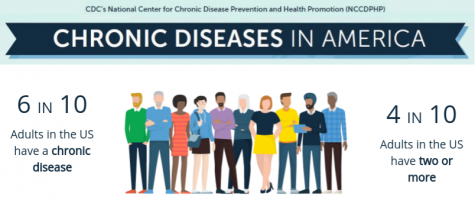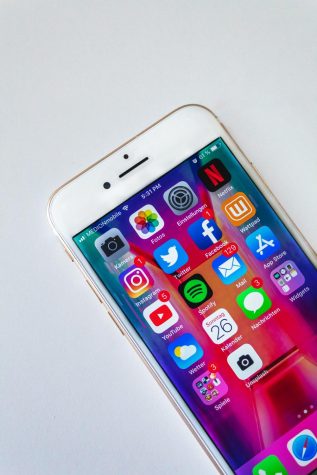A Glimpse into Being Chronically Ill During a Pandemic
Towards the beginning of the COVID-19 pandemic, along with the large amount of uncertainty and misinformation floating around about the novel coronavirus, there was a general mindset that this virus would only affect weaker people such as the elderly and people with underlying illnesses. This information, used to comfort the general population, was not really given a second thought to how it might affect those labelled as “only”. In fact, the CDC states that 6 in 10 adults in the United States have a chronic disease and 4 in 10 have more than one, demonstrating that these underlying illnesses are more common than it seems (see infographic below). Living with a chronic illness on its own adds a significant amount of stress to one’s life, and a global pandemic on top of all this can create an extremely detrimental environment, both physically and mentally, for the chronically ill.

Being chronically ill doesn’t necessarily mean that a person is more susceptible to catching the virus, but it can mean that there is a greater risk of severe illness in the case that one catches it. Some, but not all, chronic illnesses cause people to be immunodeficient, which means their immune system is weaker than the average person’s. A couple of examples of these illnesses are cancer, chronic kidney disease, and sickle cell disease. People with these illnesses, according to the CDC, are known to be “at increased risk of severe illness from COVID-19”.
Some chronic illnesses, although they may not cause immunodeficiency, can lead to other complications when sick, increasing risk of fatality. For example, people with Type 1 and occasionally Type 2 Diabetes risk going into Diabetic Ketoacidosis (DKA) when sick, which can lead to loss of consciousness and even death. DKA is often triggered by an illness because it causes the body to release high levels of hormones that counter the effect of insulin, which is a hormone that diabetics must self-administer because their pancreas cannot create it anymore. Insulin helps glucose enter the cells, and DKA occurs when the insulin isn’t there to create this process, creating a buildup of acids in the bloodstream called ketones. What makes DKA even trickier to keep an eye out for is that the symptoms of DKA are very similar to a regular virus: nausea, abdominal pain, and fatigue.
The situation that the pandemic creates for the chronically ill can also be detrimental to their mental health. The fear, anxiety, and stress that is understandably caused by a global pandemic is multiplied when you consider the physical risks that chronically ill people must be aware of. Jodi Taub, a woman with primary immunodeficiency, describes this as a “secondary anxiety around knowing we may not fare as well as others” in an interview for Health.com. Those with chronic mental illness may have an especially difficult time with this aspect of the pandemic situation. Another situation the pandemic has caused is major unemployment. Being unemployed makes it much more difficult, if not impossible, to pay for medication. If one is not already unemployed, the greater risk of unemployment during this time may add to the mental burden that the chronically ill already carry.
The ableist mindset introduced earlier is also another threat to mental health. Being used as a comfort statistic isn’t comforting, especially when that statistic is saying that you are more likely to die from this virus. It makes it seem like people with chronic illnesses are disposable and less valuable to society. The pandemic has also revealed other forms of ableism, like assuming everybody can use the same coping strategies and that you have to look a certain way to be “high-risk” for the virus.
Having to explain over and over again that just because I look fine doesn't mean I can be out in the world. I had to tell someone I was high risk at a blood draw today and she said 'me too well at least you aren't old like me so you'll be fine'.
— Katie Elizabeth (@shegoeso) May 6, 2020
In a poll of 157 individuals with at least one chronic illness, the majority having Type 1 Diabetes, about 72% of those polled believed that the conditions of the pandemic have negatively affected them more than someone without chronic illnesses. When asked to elaborate, many spoke about mental health, worries about access to medication, and both the changes in routine and added stress that have affected their management of the disease. Some people, like an anonymous Type 1 Diabetic woman from Mexico, believed that as a person with chronic illness, she has the “resources for being more prepared for the virus”. However, the majority of respondents had similar reasoning to Type 1 Diabetic Emily from the United States, who explained that the chronically ill have “have to live with more caution with those without”.
People with chronic illnesses have struggled with the conditions the pandemic has created more than any other group of people. As an overlooked population, their lives are often left unconsidered when it comes to decisions that may, especially for them, be life or death. As the world moves forward in this pandemic, we will continue to learn more and more, which will ideally clear up some of the uncertainties that still surround COVID-19 and hopefully relieve some of the stress currently piled on the chronically ill. In the meantime, it is crucial to respect everybody’s health and safety above all else, whether they are labelled “high-risk” or not.

Sarah Garcia is a senior at West Morris Central, and this is her second year with The Paw. In her free time, she loves to make and listen to music. She...











